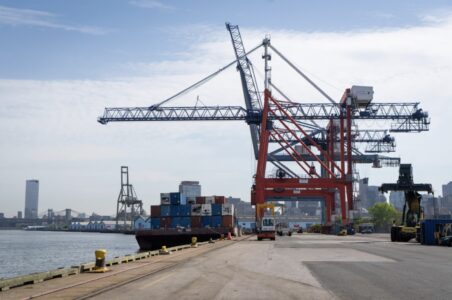Two Brooklyn businesses have had it up to here with train vibrations.
Both Louis Gellman, owner of Hilna Tires & Auto Repair Shop at 2050 Stillwell Avenue, and Nick Miraglia, owner of Miraglia Funeral Home at 8519 New Utrecht Avenue, have both been slammed with city fines in the thousands, they say, thanks to the MTA.
“I’ve owned this business for over 30 years at this location, and the noise and vibrations have never been this bad,” said Gellman of his shop, right below the D line elevated tracks. “It’s gotten much, much worse over the past four years. Every time the train comes by, my entire building and everything inside of it shakes. The screeching has become unbearable. I can’t remember the noise ever being this loud.”
The city recently fined the business $30,000, claiming it is responsible for repairing stress cracks running through the sidewalk– a story this paper broke last year. Just about a mile away, Miraglia was hit with a $15,000 fine.
Both businesses sit on the curve of the elevated D subway train, which passes Hilna Tires making a turn from 86th Street to Stillwell Avenue and Miraglia’s making a turn onto 86th Street from New Utrecht Avenue, an occurrence that happens every six to eight minutes each day.
While the MTA covers repairs to sidewalks located at bus stops, according to Assemblymember William Colton, the same cannot be said for the wear and tear of property alongside the elevated train line.
“It’s ridiculous,” said Gellman, stressing that not only is the front of his business littered with stress cracks but also the nearly 100-year-old steel pillars that hold up the elevated structure are sinking into the sidewalk. “The city wants me to pay for the sidewalk repairs, when these cracks are from the train. It’s not my fault – I don’t own or operate the train. The MTA should pay for these repairs, not me, but the city and the MTA refuse to listen.”
Miraglia agreed. “There’s something wrong here, and the city and the MTA don’t want to hear it,” he said.
Colton concurred. “The MTA needs to deal with these noise and vibration problems, because when noise vibrations are elevated, they cause serious damage to peoples’ properties and health,” he said, outside Hilna on Wednesday, August 27, citing not only the issues along the D line but also those along the R line in Bay Ridge. “This is a real problem that is negatively affecting the quality of life for people who live and work in New York City.”
But, said an MTA representative, the authority is already on the case. “The MTA routinely visits locations to investigate complaints of noise and vibration, and makes changes as appropriate to minimize the impact of subway operations on the community,” MTA Spokesperson Kevin Ortiz told this newspaper.
Nonetheless, Colton, in 2013, introduced the Transit Noise Abatement Bill, A01358, calling on the MTA to publish annual reports detailing its progress to date in abating subway noise and vibrations. One year later, the bill has been passed by both the Assembly and the State Senate and is sitting on Governor Andrew Cuomo’s desk, waiting to be signed.
If passed, the Transit Noise Abatement Bill would also mandate the MTA to publish a detailed analysis of all abatement activities planned for the year ahead.
 On the Avenue: Furry friends get special blessing!
On the Avenue: Furry friends get special blessing!  Public gets first look at massive Brooklyn Marine Terminal Project
Public gets first look at massive Brooklyn Marine Terminal Project